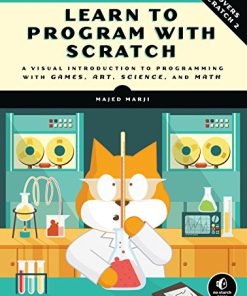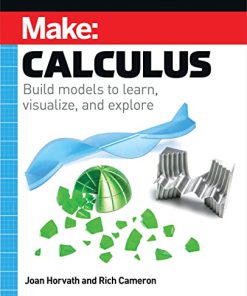Doing Math with Python Use Programming to Explore Algebra Statistics Calculus and More 1st Edition by Amit Saha ISBN 1593276400 9781593276409
$50.00 Original price was: $50.00.$25.00Current price is: $25.00.
Doing Math with Python Use Programming to Explore Algebra Statistics Calculus and More 1st Edition by Amit Saha – Ebook PDF Instant Download/Delivery: 1593276400 ,9781593276409
Full download Doing Math with Python Use Programming to Explore Algebra Statistics Calculus and More 1st Edition after payment

Product details:
ISBN 10: 1593276400
ISBN 13: 9781593276409
Author: Amit Saha
Doing Math with Python Use Programming to Explore Algebra Statistics Calculus and More 1st Edition Table of contents:
Chapter 1: Working with Numbers
Basic Mathematical Operations
Labels: Attaching Names to Numbers
Different Kinds of Numbers
Working with Fractions
Complex Numbers
Getting User Input
Handling Exceptions and Invalid Input
Fractions and Complex Numbers as Input
Writing Programs That Do the Math for You
Calculating the Factors of an Integer
Generating Multiplication Tables
Converting Units of Measurement
Finding the Roots of a Quadratic Equation
What You Learned
Programming Challenges
#1: Even-Odd Vending Machine
#2: Enhanced Multiplication Table Generator
#3: Enhanced Unit Converter
#4: Fraction Calculator
#5: Give Exit Power to the User
Chapter 2: Visualizing Data with Graphs
Understanding the Cartesian Coordinate Plane
Working with Lists and Tuples
Iterating over a List or Tuple
Creating Graphs with Matplotlib
Marking Points on Your Graph
Graphing the Average Annual Temperature in New York City
Comparing the Monthly Temperature Trends of New York City
Customizing Graphs
Adding a Title and Labels
Customizing the Axes
Plotting Using pyplot
Saving the Plots
Plotting with Formulas
Newton’s Law of Universal Gravitation
Projectile Motion
Generating Equally Spaced Floating Point Numbers
Drawing the Trajectory
Comparing the Trajectory at Different Initial Velocities
What You Learned
Programming Challenges
#1: How Does the Temperature Vary During the Day?
#2: Exploring a Quadratic Function Visually
#3: Enhanced Projectile Trajectory Comparison Program
#4: Visualizing Your Expenses
#5: Exploring the Relationship Between the Fibonacci Sequence and the Golden Ratio
Chapter 3: Describing Data with Statistics
Finding the Mean
Finding the Median
Finding the Mode and Creating a Frequency Table
Finding the Most Common Elements
Finding the Mode
Creating a Frequency Table
Measuring the Dispersion
Finding the Range of a Set of Numbers
Finding the Variance and Standard Deviation
Calculating the Correlation Between Two Data Sets
Calculating the Correlation Coefficient
High School Grades and Performance on College Admission Tests
Scatter Plots
Reading Data from Files
Reading Data from a Text File
Reading Data from a CSV File
What You Learned
Programming Challenges
#1: Better Correlation Coefficient–Finding Program
#2: Statistics Calculator
#3: Experiment with Other CSV Data
#4: Finding the Percentile
#5: Creating a Grouped Frequency Table
Chapter 4: Algebra and Symbolic Math with SymPy
Defining Symbols and Symbolic Operations
Working with Expressions
Factorizing and Expanding Expressions
Pretty Printing
Printing a Series
Substituting in Values
Calculating the Value of a Series
Converting Strings to Mathematical Expressions
Expression Multiplier
Solving Equations
Solving Quadratic Equations
Solving for One Variable in Terms of Others
Solving a System of Linear Equations
Plotting Using SymPy
Plotting Expressions Input by the User
Plotting Multiple Functions
What You Learned
Programming Challenges
#1: Factor Finder
#2: Graphical Equation Solver
#3: Summing a Series
#4: Solving Single-Variable Inequalities
Hints: Handy Functions
Chapter 5: Playing with Sets and Probability
What’s a Set?
Set Construction
Checking Whether a Number Is in a Set
Creating an Empty Set
Creating Sets from Lists or Tuples
Set Repetition and Order
Subsets, Supersets, and Power Sets
Set Operations
Union and Intersection
Cartesian Product
Applying a Formula to Multiple Sets of Variables
Different Gravity, Different Results
Probability
Probability of Event A or Event B
Probability of Event A and Event B
Generating Random Numbers
Simulating a Die Roll
Can You Roll That Score?
Is the Target Score Possible?
Nonuniform Random Numbers
What You Learned
Programming Challenges
#1: Using Venn Diagrams to Visualize Relationships Between Sets
#2: Law of Large Numbers
#3: How Many Tosses Before You Run Out of Money?
#4: Shuffling a Deck of Cards
#5: Estimating the Area of a Circle
Estimating the Value of Pi
Chapter 6: Drawing Geometric Shapes and Fractals
Drawing Geometric Shapes with Matplotlib’s Patches
Drawing a Circle
Creating Animated Figures
Animating a Projectile’s Trajectory
Drawing Fractals
Transformations of Points in a Plane
Drawing the Barnsley Fern
What You Learned
Programming Challenges
#1: Packing Circles into a Square
#2: Drawing the Sierpiński Triangle
#3: Exploring Hénon’s Function
#4: Drawing the Mandelbrot Set
The imshow() Function
Creating a List of Lists
Drawing the Mandelbrot Set
Chapter 7: Solving Calculus Problems
What Is a Function?
Domain and Range of a Function
An Overview of Common Mathematical Functions
Assumptions in SymPy
Finding the Limit of Functions
Continuous Compound Interest
Instantaneous Rate of Change
Finding the Derivative of Functions
A Derivative Calculator
Calculating Partial Derivatives
Higher-Order Derivatives and Finding the Maxima and Minima
Finding the Global Maximum Using Gradient Ascent
A Generic Program for Gradient Ascent
A Word of Warning About the Initial Value
The Role of the Step Size and Epsilon
Finding the Integrals of Functions
Probability Density Functions
What You Learned
Programming Challenges
#1: Verify the Continuity of a Function at a Point
#2: Implement the Gradient Descent
#3: Area Between Two Curves
#4: Finding the Length of a Curve
Afterword
Things to Explore Next
Project Euler
Python Documentation
Books
Getting Help
Conclusion
Appendix A: Software Installation
Microsoft Windows
Updating SymPy
Installing matplotlib-venn
Starting the Python Shell
Linux
Updating SymPy
Installing matplotlib-venn
Starting the Python Shell
Mac OS X
Updating SymPy
Installing matplotlib-venn
Starting the Python Shell
Appendix B: Overview of Python Topics
if __name__ == ‘__main__’
List Comprehensions
Dictionary Data Structure
Multiple Return Values
Exception Handling
Specifying Multiple Exception Types
The else Block
Reading Files in Python
Reading All the Lines at Once
Specifying the Filename as Input
Handling Errors When Reading Files
Reusing Code
People also search for Doing Math with Python Use Programming to Explore Algebra Statistics Calculus and More 1st Edition:
r using python
doing math in r
is there math in python
which programming language is used in python
is python good for coding
Tags: Amit Saha, Programming, Explore Algebra Statistics, Calculus
You may also like…
Mathematics - Mathematical Statistics
Statistics and Data Visualisation with Python Jesús Rogel-Salazar
Computers - Programming
Mathematics - Analysis
Make Calculus Build models to learn visualize and explore 1st Edition Joan Horvath
Uncategorized
Uncategorized
Mathematics - Computational Mathematics
Education Studies & Teaching - School Education & Teaching
Rich Algebra Tasks Grades 6 12 Engaging Students in Doing Math 1st Edition Barbara J. Dougherty
Mathematics - Applied Mathematics
Algebra and Geometry with Python 1st Edition by Borzunov, Kurgalin 9783030615406 3030615405
Mathematics - Algebra











